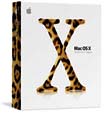FUTURE STYLE
|
Apple Mac OS X
Aqua user interface Easy to use and intuitive for new users, with powerful features for professionals Innovative organizational features such as the new Dock and Finder Fully customizable to the way you work Stability and Performance UNIX-based core operating system provides industrial-strength foundation Protected memory and advanced memory management increase system stability Preemptive multitasking boosts system performance and responsiveness Symmetric multiprocessing takes advantage of dual processor systems Modern, standards-based networking offers seamless network integration High-performance I/O architecture provides plug-and-play support for USB and FireWire peripherals Classic technology supports most of current Mac OS 9 applications Designed for the Internet Internet applications include Mail, Microsoft Internet Explorer and Internet Connect Use integrated iTools services including a Mac.com email address, iDisk storage space and more Get software updates over the Internet to keep your system up to date Graphics Quartz Extreme provides stunning onscreen graphics, PDF imaging and extensive font support OpenGL powers intense 3D graphics QuickTime 6 technology streams audio and video on the Internet Featured Technologies AppleScript Aqua Bluetooh Darwin Inkwell Java 2 Standard Edition MIDI and multichannel audio Open Directory OpenGL 3D Personal Firewall Personal Printer Sharing Quartz Extreme(1) QuickTime 6(2) Rendezvous Featured Applications Address Book DVD Player iChat iMovie iPhoto iTunes Sherlock 3 Adobe Acrobat Reader 5 Microsoft Internet Explorer 5.2 Languages: English, Japanese, French,German, Spanish, Italian, Dutch, Swedish, Danish, Norwegian, Finnish, Traditional Chinese, Simplified Chinese, Korean, Brazilian Portuguese Requirements Power Mac G3 or G4 iMac eMac PowerBook G3 or G4 iBook computer with 128 MB of physical
RAM
Preemptive multitasking Preemptive multitasking essentially works like a controller that enables the PowerPC G4 to process several different tasks simultaneously. The controller gives priority to your primary applications, while the PowerPC G4 continues to crunch away at other tasks in the background. Mac OS X uses this controller to monitor the processor at all times. The controller prioritizes tasks, makes sure activities are at peak levels, and allocates resources on the fly to ensure that every task has the processing power it needs. Processor priorities are set according to the importance of each task. If you suddenly decide to check your email or surf the web while you're in the middle of compressing an MP3 music file, Mac OS X preempts the audio compression task and re-allocates sufficient processor power to comply with your most recent request. Symmetric multiprocessing All Mac OS X applications and technologies are optimized to take advantage of the dual processor capabilities of the PowerPC G4, because symmetric multiprocessing takes preemptive multitasking to the next level. Mac OS X automatically harnesses both processors, so all of your applications benefit from the higher performance the second processor offers. Mac OS X allocates application tasks to the processors as needed, using (say) one processor to burn a DVD while it uses the other to create a new MP3 file. As serial processes these two tasks could take quite a while to complete, but with both processors in action &emdash; processing in parallel &emdash; the time to complete the two tasks is cut nearly in half. That's why complex tasks like image transformations, video compression and MP3 encoding operations are often completed in up to half the time using Mac OS X on a dual processor Power Mac G4. Multithreading Mac OS X enables performance increases by
breaking down complex processes into sub-processes, known as
threads, and executing the threads in parallel across two
processors. For example, if you were creating a transition
between two clips of video, the process would include
decoding the first clip, decoding the second clip, rendering
the transition, and re-encoding the transition back into the
original format. On Mac OS X, the system can decode the two
clips at the same time, one on each processor. And
afterwards, while the transition is rendering on one
processor, finished frames can be re-encoded on the second
processor. Because threads are processing in parallel, you
can complete a process in significantly less time. Audio in OS X: Core Audio Core Audio manages the
access to audio hardware. In contrast to previous standards,
Core Audio is an integral part of Mac OS X. Core Audio is
more flexible, even allowing access to multiple audio
hardware devices from several audio applications
simultaneously, without restarting. MIDI in Mac OS X: Core MIDI Core MIDI controls the
access to MIDI interfaces. In contrast to previous
standards, Core MIDI is an integrated part of Mac OS X. This
system-level integration contributes to reduced latency, and
a dramatic increase in system stability. MIDI interfaces
support Core MIDI (available: Emagic's Unitor8, AMT8 and MT4
USB ...) . Users can even access various MIDI interfaces
from multiple MIDI applications at the same time. |
 advanced technologic sound magazine 200 3 january issue
110
|
